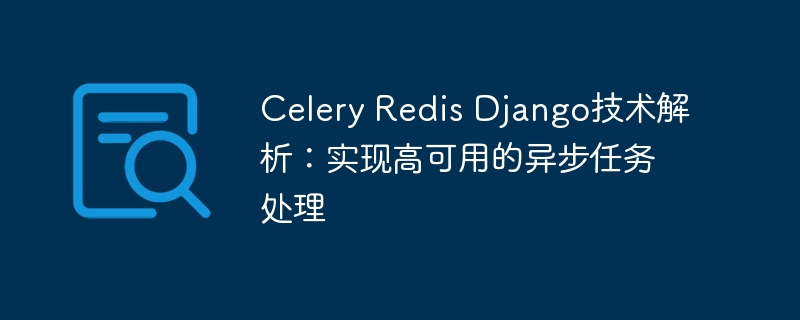Home >Backend Development >Python Tutorial >Celery Redis Django technical analysis: achieving high-availability asynchronous task processing
Celery Redis Django technical analysis: achieving high-availability asynchronous task processing
- 王林Original
- 2023-09-26 12:10:431858browse

Celery Redis Django technical analysis: To achieve high-availability asynchronous task processing, specific code examples are required
Introduction:
In today's rapidly developing Internet field, implementation Highly available asynchronous task processing is very important. This article will introduce how to use Celery, Redis and Django to implement highly available asynchronous task processing, and give specific code examples.
1. Introduction to Celery asynchronous task processing framework:
Celery is an open source distributed task scheduling framework written in Python, mainly used to process a large number of concurrent distributed tasks. It provides functions such as task queues, message passing, and task distribution, and can easily implement efficient distributed asynchronous task processing.
2. Introduction to Redis database:
Redis is an in-memory database that stores data in the form of key-value pairs. It supports persistence, publish/subscribe, automatic deletion of expired data and other functions, and is high-performance and scalable. In Celery, Redis serves as the message middleware, responsible for storing task and scheduling information to ensure reliable execution of tasks.
3. Django framework combines with Celery Redis to implement high-availability asynchronous task processing:
-
Install Celery and Redis:
In the virtual environment of the Django project, use pip Install Celery and Redis:pip install celery pip install redis
-
Configure the Django settings.py file:
Add the following configuration in the settings.py file of the Django project:# Celery配置 CELERY_BROKER_URL = 'redis://localhost:6379/0' CELERY_RESULT_BACKEND = 'redis://localhost:6379/0' CELERY_ACCEPT_CONTENT = ['application/json'] CELERY_TASK_SERIALIZER = 'json' CELERY_RESULT_SERIALIZER = 'json'
-
Create tasks:
Create the tasks.py file in the app directory of the Django project and define an asynchronous task:from celery import shared_task @shared_task def add(x, y): return x + y
-
Start the Celery worker:
In Switch to the Django project directory in the terminal and start the Celery worker:celery -A myproject worker -l info
-
Trigger the asynchronous task:
Trigger the asynchronous task by calling the view function or elsewhere in the Django project Task execution:from myapp.tasks import add result = add.delay(2, 3)
-
Get the task execution result:
Get the task execution result through the get method of the AsyncResult object:result = AsyncResult(task_id) print(result.result)
4. Sample code:
settings.py file configuration:
# Celery配置 CELERY_BROKER_URL = 'redis://localhost:6379/0' CELERY_RESULT_BACKEND = 'redis://localhost:6379/0' CELERY_ACCEPT_CONTENT = ['application/json'] CELERY_TASK_SERIALIZER = 'json' CELERY_RESULT_SERIALIZER = 'json'
tasks.py file:
from celery import shared_task
@shared_task
def add(x, y):
return x + yviews.py file:
from django.http import JsonResponse
from myapp.tasks import add
def my_view(request):
result = add.delay(2, 3)
return JsonResponse({'task_id': result.id})Result acquisition code:
from celery.result import AsyncResult
from myapp.tasks import add
def getResult(request, task_id):
result = AsyncResult(task_id)
if result.ready():
return JsonResponse({'result': result.result})
else:
return JsonResponse({'status': 'processing'})Conclusion:
This article introduces how to combine Celery, Redis and Django to achieve high-availability asynchronous task processing. By configuring Celery and Redis, defining tasks and starting Celery workers, asynchronous task scheduling and execution can be achieved. Through the above code examples, you can experience the advantages of Celery Redis Django, and further optimize and expand according to specific needs. The above is only a small part of the technical analysis of Celery Redis Django. There is more to learn and explore. I hope this article can help readers.
The above is the detailed content of Celery Redis Django technical analysis: achieving high-availability asynchronous task processing. For more information, please follow other related articles on the PHP Chinese website!

